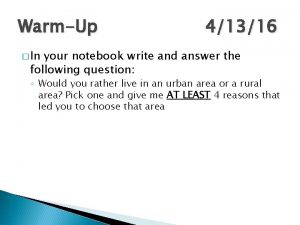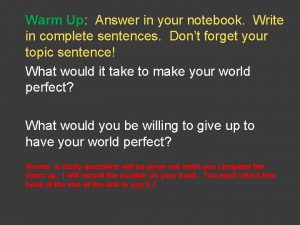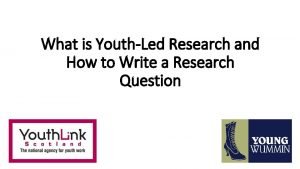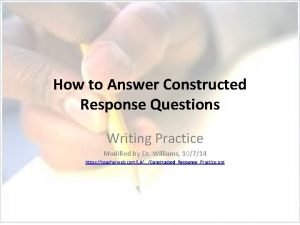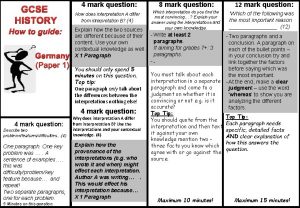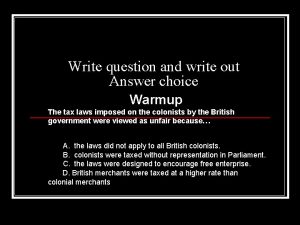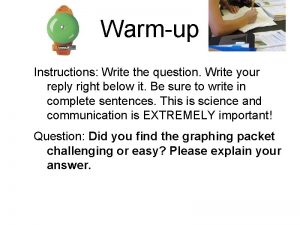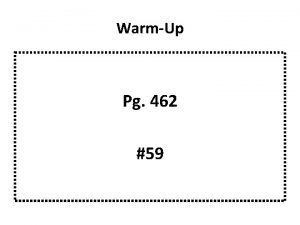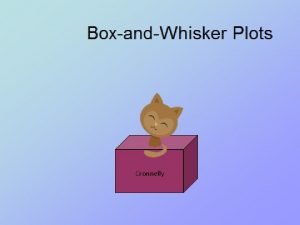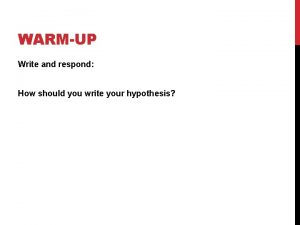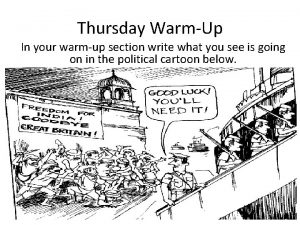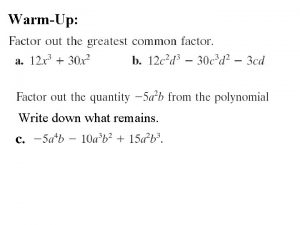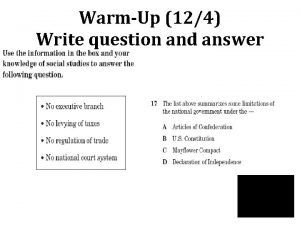WarmUp Write the question and the examples 1


































- Slides: 34

Warm-Up Write the question and the examples: 1. Tell me whether each of these is an example of chemical weathering, mechanical weathering or both: a) b) c) d) A rock getting hit by sand carried in the wind A weed growing through a crack in the sidewalk Polluted rain falling on Stone Mountain A kid leaves his bike out in the rain and it gets a rusty chain.

Get the Dirt on Soil

What is Soil? n Soil forms as rock is weathered and mixes with other materials on the surface

What is soil made out of? n Soil composition: n n n A mixture of rock particles, minerals, decayed organic material, air, and water. Humus is a dark-colored substance that forms as plant and animal remains decay Humus is rich in nutrients plants need to grow

Soil Texture n From largest to smallest: n n n Gravel Sand Silt Clay If texture is too dense or not dense enough plants may not survive Loam is made up of about equal parts of clay, sand, and silt. n Best for growing plants

Horizons n A soil horizon is a layer of soil that differs in color and texture from the layers above or below it n n Horizon A (topsoil) Horizon B (subsoil) Horizon C Bedrock

Horizon A n n Topsoil: a crumbly, dark brown soil that is a mixture of humus, clay, and other minerals This is what you walk on outside

Horizon B n n Subsoil: usually consists of clay and other particles washed down from the A horizon, but contains little humus Below the topsoil. The subsoil is a little lighter in color than the topsoil

Horizon C n n Contains only partly weathered rock This is where you will see bigger rocks and less soil

Bedrock is the solid layer of rock beneath the soil n Once the bedrock gets to the top, it becomes weathered and turns into topsoil n

How fast is soil made? n n Soil develops the quickest in areas with a warm and rainy climate Areas with limestone weather quicker than areas with granite

What else is down there? n n Plants contribute the most to humus Decomposers are the organisms that break the remains of dead organisms into smaller pieces and eat them with chemicals!!! n n n Fungi (mushrooms and molds) Bacteria Earthworms

Earthworms n n Natures mixers Earthworm poop is rich in substances plants need to grow

How do they help? n n Many burrowing animals (mice, moles, prairie dogs and gophers) break up hard, compacted soil and mix humus through it These earthworms and animals help to mix air into the soil. Plants need this oxygen to survive.


Review Questions 1. 2. 3. 4. What is soil? What is humus and how is it helpful? What are the different soil horizons? Put these in order from top to bottom: Subsoil bedrock Topsoil 5. How do earthworms and animals help the soil? Georgia Red Clay

Conserving Land Soil

Land Use n 1. 2. 3. Three things that change the land Agriculture Development Mining

Agriculture n n n This is an important land use. New farmland must be created by clearing forests, draining wetland, and irrigating (watering) deserts. Also have pastures for grazing cattle.

Development n The construction of homes, stores, office buildings, roads, bridges, and other structures.

Mining n Strip Mining causes the top layer of land to be stripped away. n n n Trees are bulldozed down. Holes are drilled through rock. Explosives break up rock. This waste is piled up on the strip next to it in order to start another strip. It leaves no tress or plants to prevent erosion. Miners must reclaim the land (prevent erosion) by replanting trees and grass.

Value of Soil n Soil is one of Earth’s most valuable resources because everything that lives depends on it.

Soil Damage and Loss n n Desertification- Where a land that is fertile turns into desertlike conditions Happens during drought.

Dust Bowl • In the 1930 s, too many plants were removed from the land. • This caused the soil to erode away.

Soil Conservation n Soil Conservation - The management of soil to prevent its destruction.

Ways to Conserve n Ways that soil can be conserved include : n n contour plowing conservation plowing leaving the soil to lie fallow (unplanted with crops) crop rotation. n Pg. 233.

Strip Cropping n n Farmers alternate strips of tall crops (corn) with strips of short crops (squash) Short crops prevent soil from washing out from tall crops which are less protected

Contour Plowing n n During the 1930 s wind erosion destroyed the land. To prevent this from happening again, farmers began to plow the land according to its shape rather than just up and down like they had in the past. It forms ridges to keep water and topsoil from flowing away. It slows water flow and saves topsoil.


Conservation Plowing n n Instead of plowing fields and leaving them exposed farmers will use machines that break up only the subsoil The weeds left will help keep the topsoil from blowing away

Terracing n n Steep hillsides are built into a series of flat terraces Slows runoff and catches eroding soil

Windbreaks n n n Rows of trees or shrubs planted along the edges of fields Block wind and trap eroding soil Sometimes can be a fence (construction sites)

Leaving land fallow n n Leaving land unplanted with crops Restores the fertility of soil

Crop Rotation n A farmer plants different crops in a field each year Some crops use less nutrients than others Certain crops, such as peanuts, add nutrients to the soil
 Costas level 2
Costas level 2 Warmup ratio
Warmup ratio Warmup 65
Warmup 65 Gmass warmup
Gmass warmup Status vs class
Status vs class Pyramid warmup
Pyramid warmup Identical rhyme examples
Identical rhyme examples Exponent properties
Exponent properties Java warmup
Java warmup Define:warmup
Define:warmup Persuasive essay quotes
Persuasive essay quotes Tom schwartz tinman
Tom schwartz tinman 65 mins
65 mins Warmup end
Warmup end Clearinghouse probe
Clearinghouse probe Read and answer. write in your notebook
Read and answer. write in your notebook In your notebook, write questions and answer them
In your notebook, write questions and answer them Now answer the following questions in your notebook
Now answer the following questions in your notebook In your notebook write questions
In your notebook write questions In your notebook write the answers so they are true for you
In your notebook write the answers so they are true for you Question word simple present
Question word simple present Contoh open-ended question
Contoh open-ended question What is situation relating question
What is situation relating question Indirect question
Indirect question Examples of supporting questions
Examples of supporting questions Compelling question definition
Compelling question definition How to write a research question
How to write a research question How to write a testable question
How to write a testable question The sky is low by emily dickinson answer key
The sky is low by emily dickinson answer key 4 mark question history
4 mark question history Testable questions format
Testable questions format In your notebook write a personal introduction
In your notebook write a personal introduction Cache memory adalah
Cache memory adalah Hình ảnh bộ gõ cơ thể búng tay
Hình ảnh bộ gõ cơ thể búng tay Ng-html
Ng-html
















